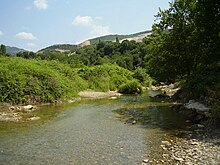Rodopi (regional unit)
|
Rodopi Regional Unit Περιφερειακή Ενότητα Ροδόπης (Ροδόπη) |
|
|---|---|
| Basic data | |
| State : | Greece |
| Region : | East Macedonia and Thrace |
| Area : | 2,543 km² |
| Residents : | 112,039 (2011) |
| Population density : | 44.1 inhabitants / km² |
| NUTS 3 code no. : | EL513 |
| Structure: | 4 municipalities |
| Website: | www.perodopis.eu |
Rodopi ( Greek Ροδόπη ) is one of the six regional districts of the Greek region of East Macedonia and Thrace . It is the only Greek regional district in which the members of the Muslim minority of Greece (predominantly Turks and Bulgarian- speaking Pomaks ) make up the majority of the population with around 55 percent. By 1994 he formed a prefecture that elected its own prefectural council. By merging with the prefecture of Evros for the prefectural elections in 1994, an area was created with the over-prefecture of Rodopi-Evros, in which the majority of the population is not Muslim. With the administrative reform of 2010 , the prefecture was abolished and its competencies were given partly to the region and partly to the municipalities, which were considerably enlarged by the merger. The regional district sends nine members to the regional council; otherwise it has no political significance.
The main town of Rodopis is the city of Komotini ; it is also the largest city in the area. Rodopi also includes the parishes of Arriana , Isamos and Maronia-Sapes .
Geography and infrastructure
Rodopi lies on the Aegean Sea and borders the Xanthi regional district in the west and Evros in the east. In the north, Rodopi borders the Bulgarian Kardzhali Oblast . Rodopi is served by the Autobahn 2 and a long-distance railway line.
The Ismarikos wine ( French Vin régional d'Ismaros ) is produced exclusively in Rodopi .
history
The regional district is named after the Rhodope Mountains (Greek Rodopi ), a wooded rump mountain range. The Rhodope Mountains were considered the legendary home of the singer Orpheus .
After the Balkan Wars of 1912-13, the region became part of Bulgaria . After the Greco-Turkish War , the prefecture was assigned to Greece in the Treaty of Lausanne in 1923. It became the new home of many Greek expellees who had to leave areas in Turkey (including Eastern Thrace) under this treaty. The non-Muslim Bulgarian population, however, had to evacuate these areas. During the Second World War , Rodopi fell into the Bulgarian zone of occupation and was annexed by Bulgaria. This was reversed in 1945.
Web links
Footnotes
- ↑ Results of the 2011 census at the National Statistical Service of Greece (ΕΛ.ΣΤΑΤ) ( Memento from June 27, 2015 in the Internet Archive ) (Excel document, 2.6 MB)
- ↑ Figures from a study by the National and Kapodistrian University of Athens ( Memento of the original from May 7, 2010 in the Internet Archive ) Info: The archive link was inserted automatically and has not yet been checked. Please check the original and archive link according to the instructions and then remove this notice. (engl.)
- ↑ Website of the Über-Prefecture (Greek) ( Memento of the original from September 9, 2012 in the web archive archive.today ) Info: The archive link was automatically inserted and not yet checked. Please check the original and archive link according to the instructions and then remove this notice.
- ↑ Christoph Pan: The Minority Rights in Greece , in: Christoph Pan and Beate Sibylle Pfeil: Minority Rights in Europe , Second revised and updated edition (Handbook of European Ethnic Groups, Volume 2), Vienna 2006, ISBN 978-3-211-35307-3 , P. 202

